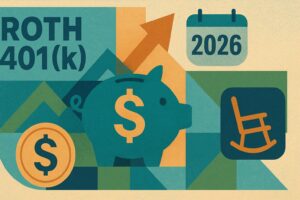Reading time: 4 minutes
Published: October 5, 2025
If you are age 50 or older, you may have relied on catch-up contributions in your 401(k) to boost your retirement savings. These extra contributions can make a real difference in the final stretch before retirement. Beginning in 2026, however, the 2026 Roth 401(k) Catch-Up Shift will change how higher earners make those contributions.

What’s Changing
The IRS has finalized regulations under Section 603 of the SECURE 2.0 Act of 2022. Starting with tax years that begin after December 31, 2025, anyone earning more than $145,000 in wages from an employer will be required to make their 401(k) catch-up contributions as Roth contributions. This means no immediate tax deduction. Instead, you pay tax up front and later withdraw the money tax-free in retirement.
For many people this will feel like losing a familiar tax break. In reality, it is the first time the tax code has required Roth contributions rather than leaving the choice to the saver. The IRS delayed the effective date to 2026 to give employers and payroll providers time to update their systems.
Contribution Limits to Know
If you are under 50, the most you can put into a 401(k) in 2025 is $23,500. Once you turn 50, you can go beyond that with catch-up contributions.
- Age 50–59: You can add another $7,500 per year, for a total of $31,000.
- Age 60–63: During these years you can make a special super catch-up of $11,250, which raises the total to $34,750.
- Age 64 and older: The extra amount drops back to the standard $7,500 catch-up.
If your prior-year wages exceed $145,000, all of those catch-up contributions, whether $7,500 or $11,250, must go into a Roth account. If your income is below that threshold, you can still choose between pre-tax or Roth contributions.
How the $145,000 Income Test Works
The $145,000 threshold is based on wages from the prior year with each employer. It applies only to employees who receive W-2 wages, as defined under Section 3121(a) of the Internal Revenue Code. It does not apply to self-employment income or partnership earnings.
Each employer must make the determination separately, using the wages it paid to you in the previous calendar year.
Example: If you earned $160,000 at Job A in 2025, your 2026 catch-up contributions at Job A must be Roth. If you earned $100,000 at Job B in 2025, your 2026 catch-ups at Job B can still be pre-tax.
There are two exceptions worth noting:
- New employees: If you recently joined a company, they may not have prior-year wage data for you. In that case, you may be allowed to make pre-tax catch-ups during the first year or two.
- Self-employed workers: If you do not take W-2 wages, this rule does not apply. You can continue making pre-tax catch-up contributions.
The $145,000 limit will be indexed for inflation, meaning it may rise slightly in future years.
What If Your 401(k) Does Not Offer a Roth?
Not every plan currently offers a Roth option. If your employer’s plan does not, and you are above the income threshold, you will not be able to make catch-up contributions at all.
Most large employers now include a Roth 401(k), and adoption has grown rapidly. This new rule is expected to accelerate that trend. If your plan still lacks a Roth feature, ask your HR department whether it will be added before 2026.
The Upside of the Roth Shift
Losing the upfront tax deduction can sting, but there are some potential advantages:
- Tax-free retirement income: Withdrawals from Roth accounts are not taxed in retirement, which can provide flexibility and peace of mind.
- Better tax diversification: Many savers already have a large share of their wealth in pre-tax accounts. Adding Roth balances creates more options when deciding how to draw income later.
- Protection against higher future tax rates: If tax rates rise, having Roth savings could leave you better off.
What to Do Now
- Check your plan. Confirm whether your employer offers a Roth 401(k). If not, ask whether it will be added.
- Look ahead. Estimate whether your income will exceed the $145,000 threshold and plan accordingly.
- Balance your tax picture. Review how much of your savings are pre-tax versus Roth and consider whether you need to diversify.
- Stay consistent. Even with these changes, the regular $23,500 contribution limit remains an important piece of tax-advantaged savings.
Key Takeaway
High earners age 50 and above will no longer be able to make pre-tax catch-up contributions after 2025. While it removes a popular deduction, it also creates a chance to build more Roth savings. For many, that shift could strengthen retirement income flexibility for years to come.
To make the most of your retirement planning, consider these essential retirement planning tips for people in their 50s.